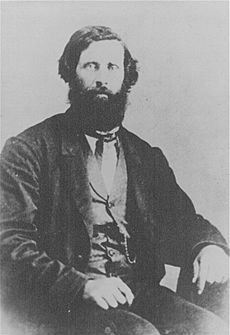Home on the Range facts for kids
Quick facts for kids "Home on the Range" |
|
|---|---|
| Song | |
| Genre | Western folk song |
| Composer(s) | Daniel E. Kelley |
| Lyricist(s) | Brewster M. Higley |
| Regional anthem of | Kansas |
|---|---|
| Lyrics | Brewster M. Higley |
| Music | Daniel E. Kelley |
| Adopted | June 30, 1947 |
"Home on the Range" is a very famous cowboy song. Many people call it the "unofficial anthem" of the American West. Dr. Brewster M. Higley wrote the words (lyrics) for this song as a poem called "My Western Home" around 1872 or 1873.
On June 30, 1947, "Home on the Range" became the official Kansas state song. In 2010, a group called the Western Writers of America picked it as one of the top 100 western songs ever!
Contents
History of the Song

In 1871, Dr. Higley moved from Indiana to Smith County, Kansas. He got land there through the Homestead Act. He lived in a small cabin near West Beaver Creek.
Higley was inspired by the beautiful nature around him. He wrote his poem, "My Western Home," which was printed in a local newspaper in 1873 or 1874. His old cabin is now a special historical place called the Home on the Range Cabin.
Daniel E. Kelley (1808–1905) was a friend of Higley. He was also a musician. Kelley created a tune for Higley's poem on his guitar. The original poem was a bit different from the song we know today. For example, it didn't have the words "on the range."
Ranchers, cowboys, and other settlers in the West loved the song. It became like a special song for people living in the countryside. The song spread across the United States in different forms. In 1925, a composer named David W. Guion arranged it as sheet music.
The song has been known by several names, but "Home on the Range" is the most common. It became the official state song of Kansas on June 30, 1947. It's also seen as the unofficial song of the American West.
Song's Popularity and Lawsuit
On September 27, 1933, famous singer Bing Crosby recorded "Home on the Range." At that time, no one was really sure where the song came from. It had been published in 1910 in a book by John Lomax. Lomax said he learned it from a saloon owner in Texas.
Because the song was so popular, a couple named William and Mary Goodwin sued in 1934. They said they owned the copyright to a similar song called "An Arizona Home." This lawsuit started a big search to find out the true history of "Home on the Range."
It turned out that the song's words had caused arguments before. In 1876, a newspaper accused another paper of copying Higley's poem. Later, a man named Samuel Moanfeldt investigated the song's history because of the 1934 lawsuit. He found that Dr. Higley had indeed written the poem, and Daniel E. Kelley had set it to music. It seems that cowboys on the Chisholm Trail helped make the song famous across many states.
Modern Uses of the Song
"Home on the Range" has been recorded by many famous artists. Bing Crosby recorded it again in 1938 and 1939. Frank Sinatra also recorded it in 1946. Other singers include John Charles Thomas, Connie Francis, Gene Autry, Boxcar Willie, Burl Ives, Pete Seeger, Johnnie Ray, Slim Whitman, Steve Lawrence, and Tori Amos.
The song is often played in concerts that celebrate American patriotic music. It's also used a lot in plays and movies. It was even the opening theme music for some early Western films starring Ray "Crash" Corrigan.
In Movies and TV
You can hear "Home on the Range" in many films:
- The 1937 comedy The Awful Truth (sung by Irene Dunne and Ralph Bellamy).
- The 1948 film Mr. Blandings Builds His Dream House (sung by Cary Grant and Myrna Loy).
- The 1967 musical You're a Good Man, Charlie Brown (sung by the cast).
- The 1980 film Where the Buffalo Roam (sung by Neil Young).
- The 2009 film The Messenger (sung by Willie Nelson).
- The 1946 Western film Colorado Serenade (sung by Roscoe Ates).
- Actor Harry Dean Stanton sings a part of it in the 1985 film One Magic Christmas.
- A funny version is sung by the bad guy in the 1990 animated film The Rescuers Down Under.
The song has also appeared in cartoons for kids and adults:
- The 1954 Looney Tunes cartoon Claws for Alarm (sung by Porky Pig).
- Bugs Bunny sings it in The Fair-Haired Hare (1951) and Oily Hare (1952).
It was used in The Simpsons episode "Lisa's Substitute" (1991). It also appeared on the TV show Shining Time Station. In the TV series GLOW, Debbie Eagan (played by Betty Gilpin) sang a part of it.
The band Vikingarna recorded an instrumental version in 1981 called "Home on the Ranch."
In 2017, a special film was made about the song. It told the story of how the song started and the lawsuit from the 1930s. The film included music from bands like Kansas and Sons of the Pioneers.
See also
 In Spanish: Home on the Range (himno) para niños
In Spanish: Home on the Range (himno) para niños

